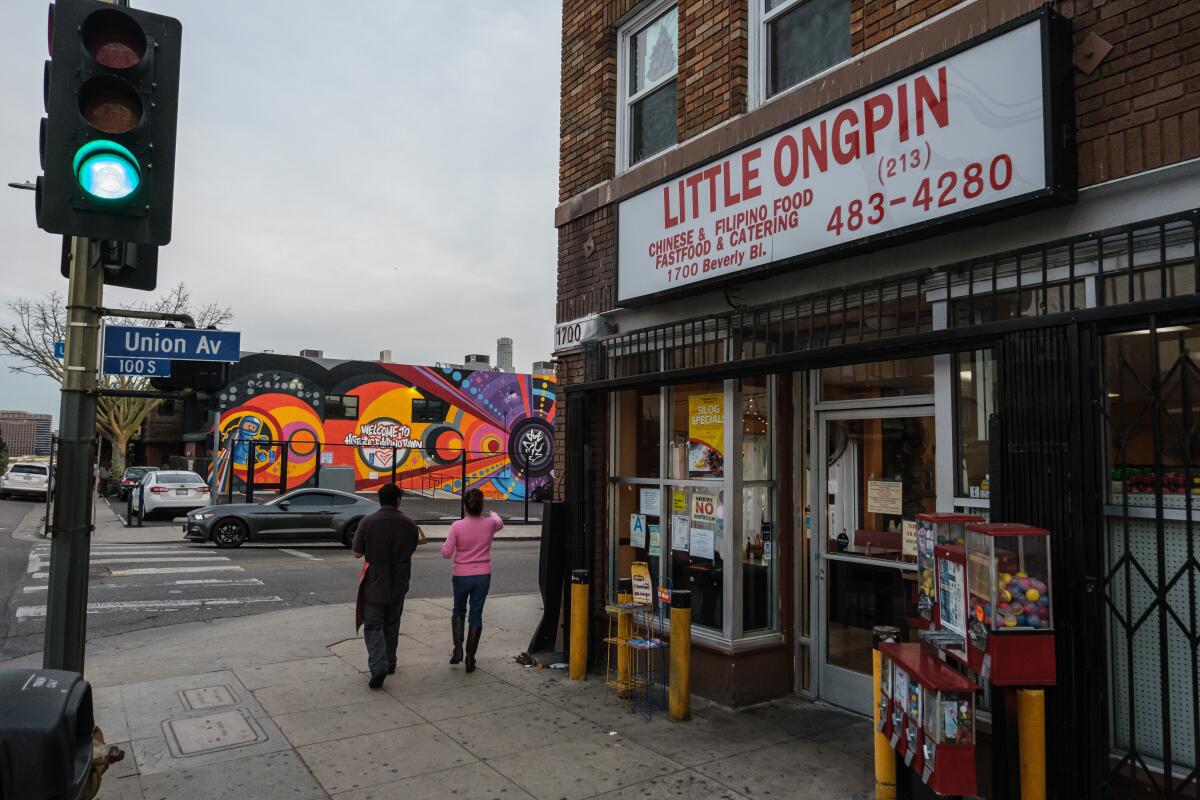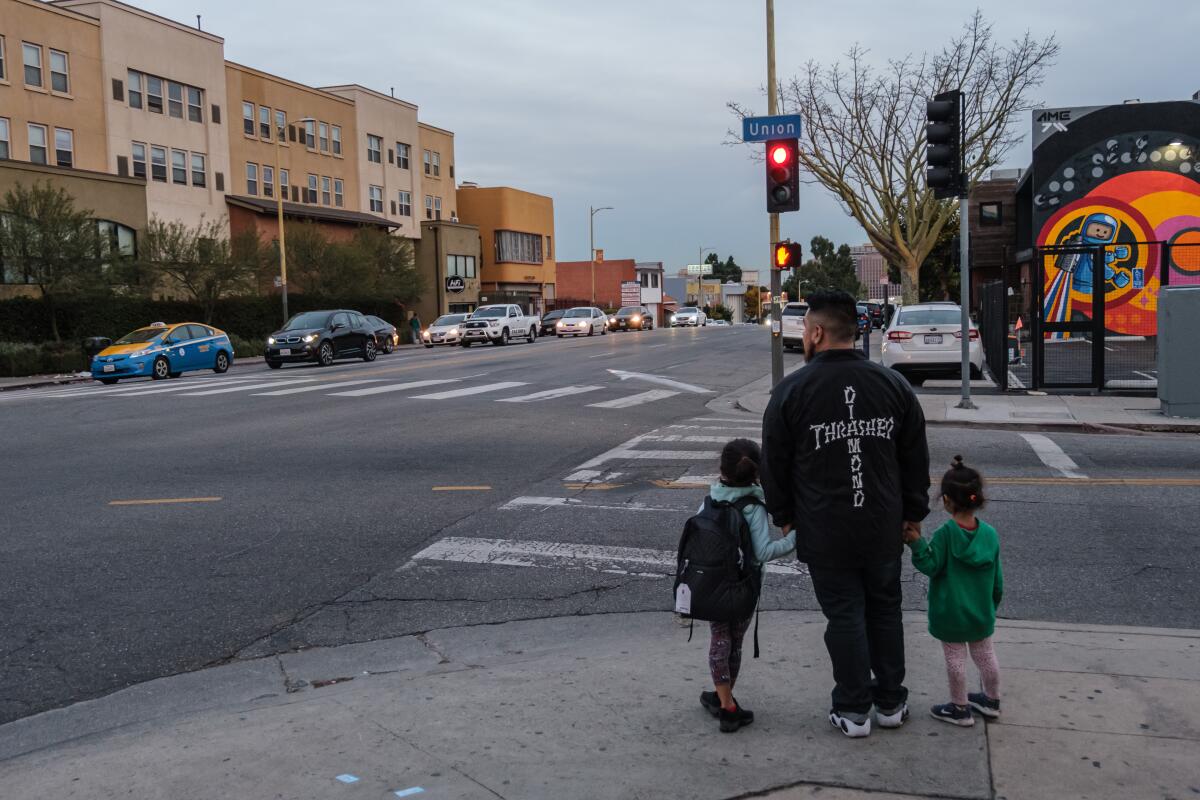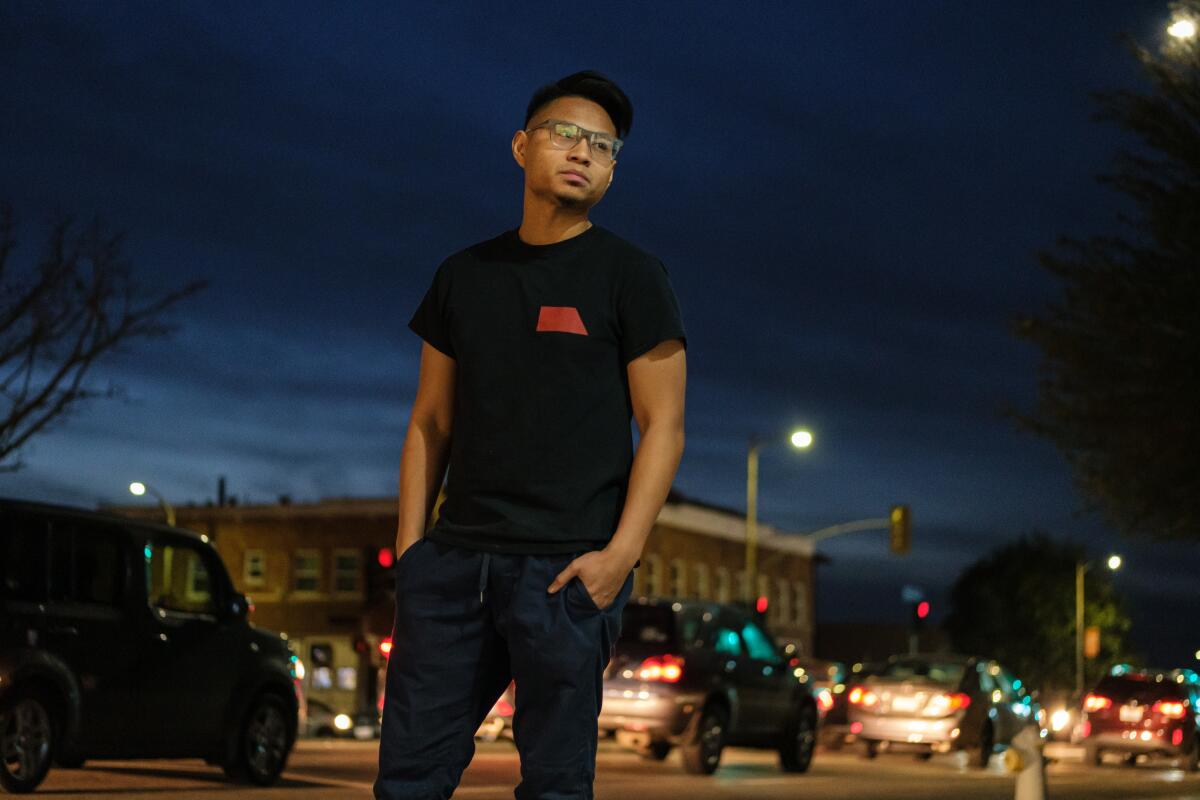Column: Here’s how HiFi, or Historic Filipinotown, got its name

Raven Castro, 21, recently moved to an apartment in Historic Filipinotown two blocks from his childhood home.
A lot feels familiar, like the slope of the pavement under his feet as he walks the route he and his mother used to take to his elementary school, or the chlorine stench at Echo Park Pool, where his father taught him to swim as a child.
But so much has changed. A disproportionate number of his neighbors are white people who own Volkswagen Jettas. As a kid he would often describe his neighborhood as Echo Park because no one knew any other name, but last September, Historic Filipinotown was named the fifth coolest neighborhood in the world by Time Out magazine. And lately the neighborhood has started to go by a new name: HiFi.
I first encountered HiFi, a shortening of Historic Filipinotown, six years ago as a Snapchat location filter — an illustrated icon you can use to decorate your posts when you’re using the app in a certain location.
Soon HiFi was all over my social media feeds and hashtags, stitched onto snapback hats and even inked in tattoos. And last year, the restaurant HiFi Kitchen opened in the neighborhood, started by a restaurateur who was born and raised there.
So I started to wonder: Where did the name HiFi come from?
Neighborhoods in L.A. often have multiple names, official and unofficial. Westlake, which contains Historic Filipinotown, is an incredible maze of them.
Some names express pride and intimacy, like P-town, or Fil-town. Other unofficial names took their significance from local landmarks, like “Tommy’s district,” a reference to the beloved late-night chili burger spot, or “around Bahay Kubo,” the longtime Filipino restaurant on Temple Street, or “MacArthur Park,” a reference to the park named for WWII Gen. Douglas MacArthur in the neighborhood’s southern part.
Other names are aspirational, like those you might encounter in real estate listings for the area: “South Silver Lake,” or “South Echo Park.” A recently proposed aesthetic plan for the area has seemingly established a new unit of geography, “North Westlake.”
Official names in Los Angeles are often the product of narrow political or historical considerations and subject to manipulation by special interests. They only occasionally have meaning to the current residents of those neighborhoods.
And yet names often set our expectations about neighborhoods, especially ethnic neighborhoods. We hear Koreatown, Thai Town, and Little Armenia and we expect a neighborhood in which a majority of residents are people of that background, engaged daily in the cultural practices of their homelands, voluntarily clustering in that neighborhood because of the comforts of community.
But when you take a step back, these assumptions form a bizarre and rigid template that ethnic communities almost never fit. It’s like expecting all movie stars to live in Hollywood, right along Hollywood Boulevard. These assumptions can prevent us from truly understanding what’s at stake when these communities change.
Names, especially new ones like HiFi, can also signal change. And Historic Filipinotown is changing.
So this week, I’ll look at how Historic Filipinotown, or HiFi, got its name. And next week I’ll write about how changes are coming to the neighborhood.
::

Historic Filipinotown was recognized officially in 2002. But when Castro’s family first settled in the neighborhood in 2004, they never heard anyone call it that. They just knew it as a place where Filipinos could get help starting their lives in the U.S.
Castro’s mother had just $100 in savings when she arrived, and the Filipino community around them became their safety net. Friends helped his dad, Ruel, find a job installing satellite dishes. His mom, Lyn, found a job as a nurse at Silver Lake Medical Center, back when it was called City of Angels Medical Center.
“It didn’t feel like anything. It was just a Filipino neighborhood. It just felt normal,” Castro said.
For those who have needed it to exist, the neighborhood has never really had an official name. For more than a century, the hills east of downtown Los Angeles have been known to immigrants as a place where a friend, a family member or a community organization might help you get on your feet. Like most ethnic enclaves in Los Angeles, it didn’t form by choice — the area was one of the few places in the city where nonwhite people could buy and rent homes, and offered a necessary shelter from racism and targeted police brutality.
Filipinos began to buy houses in large numbers there in the 1950s, after the historic Little Manila community in downtown was displaced by a city-led “revitalization effort.” Little Manila businesses like Traveler’s Cafe, a favorite hangout of the Filipino poet Carlos Bulosan, moved farther west along Temple Street to what is now Historic Filipinotown.
Conversations about an official designation for Historic Filipinotown began in the 1970s. Filipino investors banded together to build a Filipinotown business district. Filipino grocery stores, office complexes, schools and restaurants went up. Community leaders began to lobby in earnest for the creation of an officially designated Filipino neighborhood, modeled after Chinatown, Koreatown and Little Tokyo.
Many of their concerns were practical. Ethnic groups in Los Angeles, deprived of political power by redistricting and other forces, often sought officially designated neighborhoods as a way of gaining political and economic visibility. A designation would help the neighborhood attract investment and serve as a focal point for acquiring political influence. And an ethnic district would help employ recent immigrants or give them a place to start their own business.
But for some, establishing a Filipinotown in L.A.’s mosaic was also an important status symbol.
The lifting of immigration quotas meant that in the 1980s Filipinos would become the largest Asian American group in the United States, with more than 219,000 Filipinos living in Los Angeles County alone. The absence of a vibrant, thriving Filipino enclave — especially as Chinatown, Little Tokyo and Koreatown had by then obtained official recognition — was seen as a sign of cultural invisibility and political impotence.
Critiques even came from the Philippines. When Rodolfo Vera Quizon, one of the most famous comedians in the Philippines, came to Los Angeles in 2008 to accept an award, he took the opportunity to scold the Filipino American community on their perceived lack of political and economic clout.
“We Filipinos need to unite. Why is there a Chinatown, Japantown, and Koreatown here in L.A., but no Filipinotown here or anywhere in the U.S.?” Quizon said in his acceptance speech. “We are invisible here!”
In 2002, when then-Councilman Eric Garcetti sponsored a bill officially designating the area as Historic Filipinotown, many saw it as the reward for a long struggle and an important measure of how far Filipinos had come in America. While their friends bought bigger homes out in the suburbs, they had stayed, enduring crime and economic decline.
“It was a sign to everyone that Filipinos in America, we have arrived,” said Cecilia Ramos, who with her husband financed and developed two apartment complexes along Temple Street and a double-decker strip mall, Luzon Plaza, named for the largest and most populous island in the Philippines.
Historic Filipinotown gave the neighborhood a name and identity, and brought much-needed visibility to the community. But once visibility came, it was hard to control. And even some of the people intimately involved in the designation effort have begun to wonder if Historic Filipinotown’s naming would ultimately benefit the community it was named for.
George Villanueva, who oversaw the 2002 designation push as a field deputy in Garcetti’s office, was born and raised in Historic Filipinotown. About four years ago, he retired from a 15-year career in city government, disillusioned with the effects of some of his work.
Villanueva became an assistant communications professor at Loyola University Chicago. And last year, he published a paper in an academic journal assessing and analyzing his regrets about his work in city government, styled as a letter to his past selves.
He was proud that the Historic Filipinotown effort had given the community unprecedented access to political power. Several Filipino Americans were appointed to city commissions, and more would later take positions in Garcetti’s administration when he became mayor.
But the designation had also, in Villanueva’s view, helped turn the community into a target for gentrification. He worried that his work had begun an inexorable economic process during which, he wrote, “the original celebration of community ethnic identity and support for existing low-income resident needs slowly fades away in favor of exploiting racial difference for capitalist profit.”
Villanueva still believes that the visibility brought by the designation has created positive change in the neighborhood. But now he worries that the community he helped organize will be replaced by a new one.
“I continue to wonder why such revitalization never turns out the way I hoped. Why don’t low-income people of color get to stay in their neighborhoods and benefit from these investments, instead of giving way to gentrifying classes?”
::

Before it existed as a designation, the idea of a Filipinotown fueled Joe Bernardo’s teenage fantasies of belonging.
Bernardo’s family lived in Historic Filipinotown briefly when they first arrived in America but soon moved to a predominantly white suburb of the San Fernando Valley. His friends were largely Japanese, Korean and Chinese kids, all of whom had experiences or connections to Little Tokyo, Chinatown or Koreatown.
The absence of a Filipinotown fed a larger feeling of cultural invisibility that stemmed from a lifetime of being mistaken for Latino or excluded from Asian American circles.
“There was a kind of unspoken link between ethnic identity and urban space, particularly in the ‘90s when youth culture was arguably more racially segregated,” Bernardo said.
Bernardo fantasized about a Filipino neighborhood where everyone looked like him, a place where he could take outsiders to share and celebrate his culture. In high school, he sketched out his fantasy with a pencil and a ruler on a sheet of computer paper.
Bernardo’s Filipinotown had restaurants, a cockfighting pit, streets named after national heroes like José Rizal, and even a neighborhood named for Lapu Lapu, the Filipino ruler who resisted Spanish colonization and defeated Portuguese explorer Ferdinand Magellan in battle in 1521.
For Bernardo, Filipinotown was not just a passing teenage fantasy. After Villanueva left his position in Garcetti’s office, Bernardo took over his role. He helped direct city funds to pay for signs and banners marking Historic Filipinotown, and helped erect the first Filipino World War II Veterans memorial in Lake Street Park.
In graduate school, he wrote a doctoral dissertation about the history and origins of Historic Filipinotown, and he argues that for immigrant communities, ethnic enclaves were a necessary precursor to political and economic advancement.
Filipinotown was important to Bernardo as a child, but he isn’t sure if other Filipinos agree. Because Filipino immigrants often arrive with high levels of education and English ability, he says they tend to form more assimilated communities in places like Eagle Rock, Carson and West Covina. A recent episode of “This Filipino American Life,” a podcast he hosts with friends, returns to the subject with more skepticism.
“Filipino ethnic enclaves: Do they exist? Do we need them?”
It’s a natural question to ask, one that I’ve heard a lot and asked myself over the last few years. Many enclaves formed as vital shelters for immigrants, and when immigration flows changed, the enclaves inevitably changed as well. Sons and daughters move on to better jobs in bigger cities, abandoning family businesses and selling off inherited properties. But if this is progress, why does it feel like we’re losing so much?
Ultimately it’s up to the second generation to decide what future ethnic enclaves will have.
So I asked Castro why he’s moving back to Historic Filipinotown after all these years. He said that his family has always gone there to start their lives, and it just made sense.
Like a few years ago, when his father lost his job at a Honda mechanic downtown and his parents filed for divorce, his father moved back in Historic Filipinotown.
Ruel couch-surfed with friends until he eventually landed in a tiny back house with room for a twin-sized bed and a desk, empty besides a small framed photo of his son. There, he began to study for nursing school and rebuild his life.
Castro spent weekends in that back house, studying for the SAT by the light of a tiny lamp and sharing the small bed with his father, who would study for nursing school. Sometimes his father would turn to him and say, “Look at me, son. This is why you have to do better. You don’t want to end up like this.”
His father got his nursing degree and eventually moved out of Historic Filipinotown. Castro got into USC, joined a Filipino culture club and eventually became its president. He often found himself back in Historic Filipinotown, volunteering with community organizations, attending open mic nights or having dinner with friends at the Park’s Finest. He learned about the neighborhood’s history and began to see its connections to his own.
When he graduated a few months ago and got a job offer from an accounting firm downtown, Historic Filipinotown was the first place he looked for an apartment.
He likes — and sometimes uses — the name HiFi, actually. And he’s proud to see so much interest in the neighborhood, even if the characters and settings of his childhood are fading.
Whatever happens next, he’s just hoping to be a part of it.
More to Read
Sign up for Essential California
The most important California stories and recommendations in your inbox every morning.
You may occasionally receive promotional content from the Los Angeles Times.











